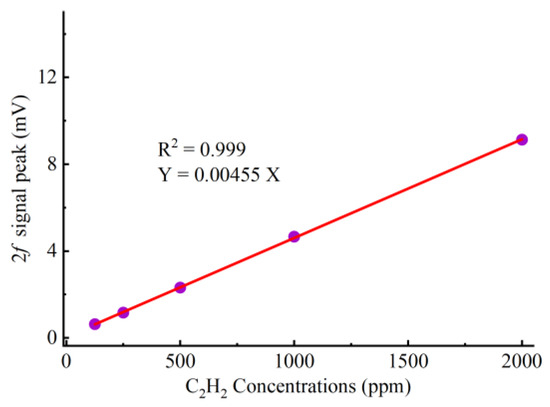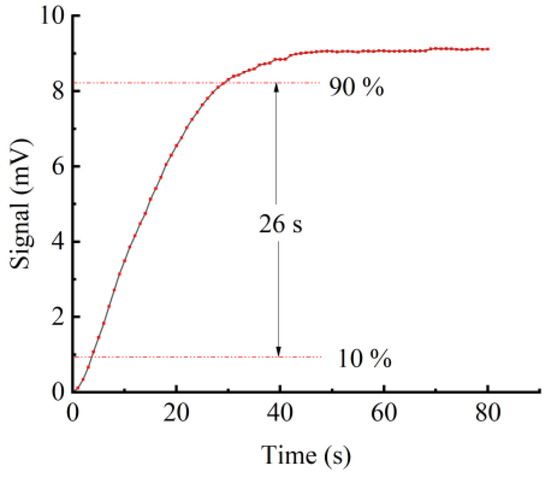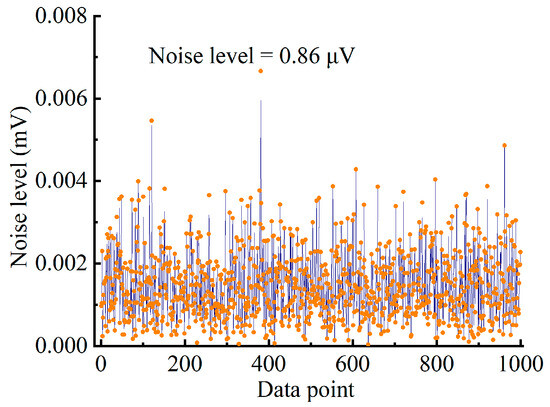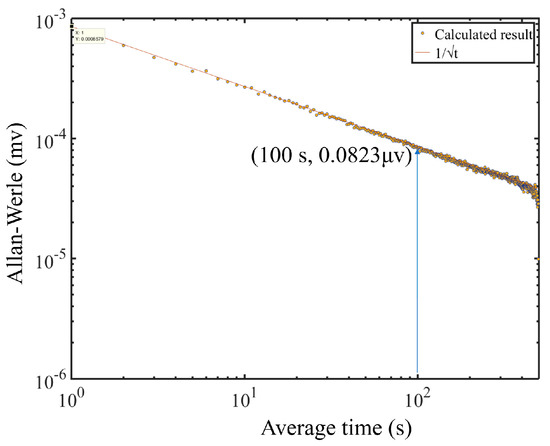Abstract
In this work, a miniaturized Y-sphere coupled photoacoustic (YSCPA) sensor is proposed for trace C2H2 gas detection. The cavity volume of the designed YSCPA sensor is about 0.7 mL. The finite element method (FEM) has been performed to analyze the comparative performance of the YSCPA sensor and T-type PA sensor, indicating that the first-order resonance frequency (FORF) of the newly proposed YSCPA sensor has been reduced by half while the PA signal has been improved by a factor of 3 compared to the T-type PA sensor. C2H2 is employed as a target gas to test the performance of the YSCPA sensor. The experimental test results show that the response time of the gas is 26 s. The minimum detection limit (MDL) reaches 189 ppb at a lock-in integration time of 1 s. By extending the lock-in integration time to 100 s, the MDL of the designed PA sensor is reduced to 18.1 ppb. The designed YSCPA sensor has the advantages of small size, low gas consumption, simple structure, and high sensitivity, which is expected to be an effective solution for rapid and real-time monitoring of dissolved C2H2 gas in transformer oil.
1. Introduction
Dissolved gas analysis (DGA) in oil has been widely recognized as a reliable method for detecting initial transformer faults [1,2]. The concentration of dissolved acetylene (C2H2) gas in the transformer oil will be abnormal at the early stage of partial discharge faults in the transformer. Therefore, real-time detection of C2H2 gas concentration can predict possible faults in transformers. Traditional methods for detecting characteristic gas concentrations in transformers include gas chromatography detection [3,4] and the gas sensor method [5]. The gas chromatography detection method has the disadvantages of a long response time, a complicated operation process, bulky volume, and the need for the column to be replaced periodically. The disadvantages of the gas sensor method for transformer fault gas monitoring are its poor selectivity, low sensitivity, and gas cross-sensitivity. Therefore, neither of the above gas detection methods are suitable for the real-time monitoring of transformer characteristic gas concentrations. However, photoacoustic (PA) spectroscopy (PAS) has the advantages of small size, simple system, high sensitivity, short response time and strong selectivity, which makes it an effective tool for real-time detection of dissolved gases in transformer oil [6,7,8,9,10,11]. Photoacoustic spectroscopy is based on the principle of the PA effect for trace gas detection, which can be summarized as the absorption of light by a gas causing a periodic heat release, which ultimately produces a photoacoustic signal that is detected by a microphone. To date, various concepts have been proposed for gas sensing, such as quartz-enhanced PAS (QEPAS) [12,13,14,15] and cantilever-enhanced PAS (CEPAS) [16,17,18,19]. However, these enhanced PAS technologies are susceptible to temperature and humidity effects that can lead to measurement errors in gas concentrations.
There is a need to develop a photoacoustic cell (PAC) resonance-enhanced PAS for real-time gas detection. Wang et al. reported an H-PAC resonance-enhanced PAS for trace C2H2 detection [20]. In order to further enhance the sensitivity of PAS, Zhang et al. proposed a novel ellipsoid PAC resonance-enhanced PAS, which can enhance the photoacoustic signal amplitude compared with the H-PAC photoacoustic cell resonance-enhanced PAS [21]. In order to further reduce the response time of the gas, Gong et al. proposed a T-PAC resonance-enhanced PAS for trace C2H2 detection [22]. Through simulation analysis and experimental verification, it can be seen that compared with H-type PAC resonance-enhanced PAS, T-PAC resonance-enhanced PAS had shorter response time and higher photoacoustic signal. However, all of the above resonance-enhanced PAS methods operate at less than 2000 Hz, so environmental noise has a significant impact on them. In 2024, Zhu et al. proposed a multi-mechanism enhancement based on the acoustic enhancement of the spherical PAC and mechanical enhancement of the cantilever [23]. The first-order resonance frequency (FORF) of the reported spherical photoacoustic cell was close to 6000 Hz. Therefore, it was affected little by the ambient noise, and the overall signal-to-noise ratio was very good. However, the volume of the spherical PAC was large, and therefore the gas response time was very long. Therefore, it became a challenge to design PA sensors with a short response time, high sensitivity, and high resonance frequency.
In this paper, we propose a miniaturized Y-sphere coupled photoacoustic (YSCPA) sensor for rapid and real-time monitoring of dissolved acetylene gas in transformer oil. The cavity volume of the designed YSCPA sensor is about 0.7 mL. The results of finite element analysis show that the performance of the designed YSCPA sensor is better than that of the conventional T-type PA sensor. Experimental results show that the proposed sensor has an C2H2 detection limit on the order of ppb and a gas response time of 26 s. The designed YSCPA sensor has the advantages of small size, low gas consumption, simple structure, and high sensitivity, which is expected to be an effective solution for rapid and real-time monitoring of dissolved acetylene gas in transformer oil.
2. Sensor Design
Figure 1a–c show the structural schematic, mechanical sketch, and physical drawing of the YSCPA sensor. The sensor includes a collimator, three cavities, and a microphone. The dimensions of cavity 1 are upper radius (R1) = 7.5 mm; bottom radius (R2) = 1.5 mm; and length (L) = 8 mm. The dimensions of cavity 2 are radius (R3) = 1.5 mm and length (L) = 8 mm. The dimensions of cavity 3 are radius (R4) = 3 mm. A hole with a diameter of 1 mm and a length of 0.5 mm is opened at the end of cavity 3 for transmitting the photoacoustic signal to the microphone. The YSPAC is made of photosensitive resin with a density of 1.3g/cm and processed by laser 3D printing technology with a manufacturing accuracy of 0.2 mm. The three-dimensional models of the T-type PA sensor and the YSCPA sensor are established by using the finite element method (FEM). The simulated physical field uses thermo-viscous acoustics for two PA sensors, thereby making the simulation results closer to the experimental test results. In addition, a 1-unit heat source is placed in the buffer chamber portion of two PA sensors to generate the PA signal. The frequency sweep ranges of the T-type PA sensor and the YSCPA sensor are set to 3500–5000 Hz and 8500–10,000 Hz, respectively.

Figure 1.
(a) The structural schematic of the YSCPA sensor. (b) The structural mechanical sketch of the YSCPA sensor. (c) The physical drawing of the YSCPA sensor.
Figure 2 shows the simulated amplitude–frequency response curves of the three PA sensors. Figure 2b shows that the PA signal of the Y-type PA sensor is nearly doubled and the resonance frequency is reduced by 440 Hz compared to the T-type PA sensor. In addition, Figure 2 shows that compared with the T-type PA and Y-type PA sensors, the newly proposed YSCPA sensor has a lower FORF (4325 Hz), as well as a higher PA signal (1.6 × 10-6 Pa).

Figure 2.
Simulated amplitude–frequency response curves. (a) The YSCPA sensor. (b) The T-type PA and Y-type PA sensors.
Figure 3 depicts the modal analysis of PA pressure fields of the three PA sensors at their FORFs, and it can be observed that the maximum sound pressure of three PA sensors is distributed at the end of the sensor, and thus the condenser microphone is placed here to acquire the maximum sound pressure.

Figure 3.
The modal analysis of PA pressure fields. (a) The YSCPA sensor. (b) The T-type PA and Y-type PA sensors.
3. Experiment Results and Discussion
3.1. Instrumentation
A schematic diagram of the C2H2 photoacoustic sensor based on Y-sphere coupling is shown in Figure 4. The absorption lines of C2H2 (1 ppm) and water vapor (1000 ppm) at 1530–1535 nm are shown in Figure 4b. It is observed that the absorption line of acetylene gas at 1532.8 nm is strong and not interfered by water vapour. Therefore, the C2H2 gas absorption line at 1532.8 nm is selected for testing the sensor performance. The system was equipped with a distributed feedback (DFB) diode laser as an C2H2 gas excitation source. The laser temperature and drive current are set to 24.9 °C and 62.9 mA, respectively. The erbium-doped fiber amplifier (EDFA) increases the optical power of the DFB laser to 200 mW. The incident beam is processed by the collimator and directly enters the sensor, which generates PA signals after reacting with the C2H2 gas to be measured, and then is detected by the condenser microphone. Finally, the condenser microphone (B&K 4189, Brüel & Kjær, Nærum, Denmark) collects the electrical signals which are first amplified by a preamplifier and then output to a lock-in amplifier (LIA) (SRS, SR830, Sunnyvale, CA, USA) for processing and transmitted to the computer via a data acquisition card (DAQ).

Figure 4.
(a) Sketch of the experimental test system with the YSCPA sensor. (b) Absorption lines of C2H2 (1 ppm) and water vapor (1000 ppm).
3.2. Experimental Results
The second harmonic (2f) technique is employed to derive the PA signal. For resonant PAS gas sensor systems, the modulation frequency greatly affects the photoacoustic amplitude. Therefore, choosing the right modulation frequency to match the FORF of the YSCPA sensor can obtain an optimal PA signal. The optimal PA signal is obtained by scanning the frequency response curve of the YSCPA sensor with 2000 ppm C2H2, as shown in Figure 5. The FORF of the YSCPA sensor is observed to be 4180 Hz. The experimental resonant frequency of the designed YSCPA sensor deviates from the simulation results due to the manufacturing error in the coupling part of the 3D printed sensor. In addition, the modulation depth of the sine wave also affects the PA signal. Therefore, it is necessary to choose a suitable modulation depth. Once the operating temperature of the laser does not change, the number of waves emitted by the laser is determined by its injection current. Therefore, the modulation current of the sinusoidal wave is an important factor affecting the PA signal. The variation curve of the PA signal with modulation current is tested, as shown in Figure 6. It can be observed that the PA signal first rises and then decreases with the increase in modulation current, and the PA signal reaches the maximum when the modulation current is 62.9 mA.

Figure 5.
The frequency–response curve of the YSCPA sensor with 2000 ppm C2H2.

Figure 6.
The variation curve of PA signal with modulation current.
Two MFCs (CS200, Sevenstar, Beijing, China) are used to control the ratio of 2000 ppm C2H2/N2 gas mixture to 99.99% N2 to obtain 125–2000 ppm C2H2. Different concentrations of C2H2 (125–2000 ppm) are introduced into the YSCPA sensor to determine the 2f signal of the proposed sensor and the C2H2 linearity of the sensor. The obtained 2f signals corresponding to different C2H2 concentrations are shown in Figure 7, and the fitted curves obtained by linear fitting method are shown in Figure 8. It can be observed that the response of the sensor to C2H2 gas is 4.55 μv/ppm and the R2 reaches 0.999, indicating that the sensor has good linearity for C2H2.

Figure 7.
The obtained 2f signal corresponding to different concentrations.

Figure 8.
Fitting curves between different C2H2 concentrations and 2f peak signal.
The gas response time is an important parameter for PA sensors. Therefore, C2H2 at a concentration of 2000 ppm is introduced into the PA gas sensor to validate the gas response time of this miniaturized YSCPA sensor. The results of the response time of the test are shown in Figure 9. It can be observed that the photoacoustic signal rises from 10% to 90% in only 26 s, which is sufficient to quickly identify and warn of the dissolved C2H2 concentration in the transformer oil.

Figure 9.
Gas response time of the YSCPA sensor.
The noise level of the system is tested by passing 99.99% nitrogen through the YSCPA sensor for up to one hour until the PA signal no longer degraded. The noise points corresponding to each second of the lock-in amplifier output are continuously recorded, as shown in Figure 10. Therefore, the noise standard deviation of the system is calculated to be 0.86 μv, and the response is 4.55 μv/ppm, yielding an MDL of 189 ppb.

Figure 10.
The noise level of the YSCPA sensor-based trace C2H2 detection system.
An Allen variance has been employed to assess the long-term stability of the YSCPA sensor system. The results of Allan variance calculation are shown in Figure 11. It can be observed that the Allan variance shows a continuous decreasing trend as the lock-in integration time increases. Therefore, extending the lock-in integration time is one way to improve MDL. The MDL of the designed PA sensor is reduced to 18.1 ppb when the lock-in integration time is 100 s. In addition, the overall trend of Allen variance conforms to the fitted curve with , which indicates that the system is mainly affected by white noise and therefore has good long-term stability.

Figure 11.
The Allan variance of the YSCPA sensor.
4. Conclusions
In this work, a miniaturized YSCPA sensor is proposed for trace C2H2 gas detection. The cavity volume of the designed YSCPA sensor is about 0.7 mL. FEM has been performed to analyze the comparative performance of the YSCPA sensor and T-type PA sensor, showing that the FORF of the newly proposed YSCPA sensor has been reduced by half while the PA signal has been improved by a factor of 3 compared to the T-type PA sensor. The FORF of the newly proposed YSCPA sensor is 4180 Hz, which agrees well with the simulation results. Thanks to the sub-milliliter cavity volume of the designed sensor, the response time of the gas is only 26 s. The MDL reaches 189 ppb at a lock-in integration time of 1 s. The Allen variance results show good stability of the sensing system and provides an idea to reduce the gas detection limit by extending the lock-in integration time. The designed YSCPA sensor has the advantages of small size, low gas consumption, simple structure, and high sensitivity, which is expected to be an effective solution for rapid and real-time monitoring of dissolved C2H2 gas in transformer oil.
Author Contributions
X.C. was responsible for primary manuscript preparation and calculation. D.L. and Z.S. worked on the simulation. S.W. and Q.L. supervised the work and revised the manuscript. All authors have read and agreed to the published version of the manuscript.
Funding
This research received no external funding.
Institutional Review Board Statement
Not applicable.
Informed Consent Statement
Not applicable.
Data Availability Statement
Data is contained within the article.
Conflicts of Interest
We declare that we do not have any commercial or associative interests that represent a conflict of interest in connection with the work submitted.
References
- Mashhadzadeh, A.H.; Ghanbari, M.; Koochaki, A.; Seyyedbarzegar, S.; Ahangari, M.G. Experiment and Theory for Acetylene Adsorption in Transformer Oil. J. Mol. Struct. 2021, 1230, 129860. [Google Scholar] [CrossRef]
- Fu, L.; Zhang, J.; Pan, Y.; Lu, P. Differential Photoacoustic Spectroscopy for Flow Gas Detection Based on Single Microphone. Photoacoustics 2024, 38, 100624. [Google Scholar] [CrossRef] [PubMed]
- Lee, J.H.; Park, M.S.; Jung, H.; Choe, Y.-S.; Kim, W.; Song, Y.G.; Kang, C.-Y.; Lee, H.-S.; Lee, W. Selective C2H2 Detection with High Sensitivity Using SnO2 Nanorod Based Gas Sensors Integrated with a Gas Chromatography. Sens. Actuators B Chem. 2020, 307, 127598. [Google Scholar] [CrossRef]
- Xing, M.; Ding, W.; Li, H.; Zhang, T. A Power Transformer Fault Prediction Method through Temporal Convolutional Network on Dissolved Gas Chromatography Data. Secur. Commun. Netw. 2022, 2022, 5357412. [Google Scholar] [CrossRef]
- Fan, J.; Wang, F.; Sun, Q.; Ye, H.; Jiang, Q. Application of Polycrystalline SnO2 Sensor Chromatographic System to Detect Dissolved Gases in Transformer Oil. Sens. Actuators B Chem. 2018, 267, 636–646. [Google Scholar] [CrossRef]
- Wu, G.; Xing, J.; Gong, Z.; Ma, J.; Fan, Y.; Wu, X.; Peng, W.; Yu, Q.; Mei, L. Single Fiber-Type Double Cavity Enhanced Photoacoustic Spectroscopy Sensor for Trace Methane Sensing. J. Light. Technol. 2024, 42, 3393–3398. [Google Scholar] [CrossRef]
- Gong, Z.; Chen, K.; Yang, Y.; Zhou, X.; Yu, Q. Photoacoustic Spectroscopy Based Multi-Gas Detection Using High-Sensitivity Fiber-Optic Low-Frequency Acoustic Sensor. Sens. Actuators B Chem. 2018, 260, 357–363. [Google Scholar] [CrossRef]
- Sampaolo, A.; Menduni, G.; Patimisco, P.; Giglio, M.; Passaro, V.M.N.; Dong, L.; Wu, H.; Tittel, F.K.; Spagnolo, V. Quartz-Enhanced Photoacoustic Spectroscopy for Hydrocarbon Trace Gas Detection and Petroleum Exploration. Fuel 2020, 277, 118118. [Google Scholar] [CrossRef]
- Wu, G.; Zhang, Y.; Gong, Z.; Fan, Y.; Xing, J.; Wu, X.; Ma, J.; Peng, W.; Yu, Q.; Mei, L. A Mini-Resonant Photoacoustic Sensor Based on a Sphere-Cylinder Coupled Acoustic Resonator for High-Sensitivity Trace Gas Sensing. Photoacoustics 2024, 37, 100595. [Google Scholar] [CrossRef]
- Wu, H.; Dong, L.; Zheng, H.; Yu, Y.; Ma, W.; Zhang, L.; Yin, W.; Xiao, L.; Jia, S.; Tittel, F.K. Beat Frequency Quartz-Enhanced Photoacoustic Spectroscopy for Fast and Calibration-Free Continuous Trace-Gas Monitoring. Nat. Commun. 2017, 8, 15331. [Google Scholar] [CrossRef]
- Zhang, C.; Qiao, S.; He, Y.; Zhou, S.; Qi, L.; Ma, Y. Differential Quartz-Enhanced Photoacoustic Spectroscopy. Appl. Phys. Lett. 2023, 122, 241103. [Google Scholar] [CrossRef]
- Liu, Y.; Qiao, S.; Fang, C.; He, Y.; Sun, H.; Liu, J.; Ma, Y. A Highly Sensitive LITES Sensor Based on a Multi-Pass Cell with Dense Spot Pattern and a Novel Quartz Tuning Fork with Low Frequency. OEA 2024, 7, 230230. [Google Scholar] [CrossRef]
- Wu, H.; Yin, X.; Dong, L.; Pei, K.; Sampaolo, A.; Patimisco, P.; Zheng, H.; Ma, W.; Zhang, L.; Yin, W.; et al. Simultaneous Dual-Gas QEPAS Detection Based on a Fundamental and Overtone Combined Vibration of Quartz Tuning Fork. Appl. Phys. Lett. 2017, 110, 121104. [Google Scholar] [CrossRef]
- Qiao, S.; He, Y.; Sun, H.; Patimisco, P.; Sampaolo, A.; Spagnolo, V.; Ma, Y. Ultra-Highly Sensitive Dual Gases Detection Based on Photoacoustic Spectroscopy by Exploiting a Long-Wave, High-Power, Wide-Tunable, Single-Longitudinal-Mode Solid-State Laser. Light. Sci. Appl. 2024, 13, 100. [Google Scholar] [CrossRef] [PubMed]
- Wang, J.; Wu, H.; Sampaolo, A.; Patimisco, P.; Spagnolo, V.; Jia, S.; Dong, L. Quartz-Enhanced Multiheterodyne Resonant Photoacoustic Spectroscopy. Light. Sci. Appl. 2024, 13, 77. [Google Scholar] [CrossRef]
- Guo, M.; Chen, K.; Yang, B.; Zhang, G.; Zhao, X.; Li, C. Miniaturized Anti-Interference Cantilever-Enhanced Fiber-Optic Photoacoustic Methane Sensor. Sens. Actuators B Chem. 2022, 370, 132446. [Google Scholar] [CrossRef]
- Wu, G.; Wu, X.; Gong, Z.; Xing, J.; Fan, Y.; Ma, J.; Peng, W.; Yu, Q.; Mei, L. Highly Sensitive Trace Gas Detection Based on a Miniaturized 3D-Printed Y-Type Resonant Photoacoustic Cell. Opt. Express 2023, 31, 34213. [Google Scholar] [CrossRef]
- Chen, Z.; Zhang, X.; Yang, T.; Fan, S.; Cheng, H.; Xu, G.; Zhang, Y.; Zhou, H. Detection of Trace Carbon Monoxide Based on Cantilever Enhanced Photoacoustic Spectroscopy at 2.33 Μm. Infrared Phys. Technol. 2022, 126, 104364. [Google Scholar] [CrossRef]
- Wu, G.; Gong, Z.; Li, H.; Ma, J.; Chen, K.; Peng, W.; Yu, Q.; Mei, L. High-Sensitivity Multitrace Gas Simultaneous Detection Based on an All-Optical Miniaturized Photoacoustic Sensor. Anal. Chem. 2022, 94, 12507–12513. [Google Scholar] [CrossRef]
- Wang, Q.; Wang, J.; Li, L.; Yu, Q. An All-Optical Photoacoustic Spectrometer for Trace Gas Detection. Sens. Actuators B Chem. 2011, 153, 214–218. [Google Scholar] [CrossRef]
- Zhang, C.; Wang, Q.; Yin, X. Photoacoustic Spectroscopy for Detection of Trace C2H2 Using Ellipsoidal Photoacoustic Cell. Opt. Commun. 2021, 487, 126764. [Google Scholar] [CrossRef]
- Gong, Z.; Chen, K.; Chen, Y.; Mei, L.; Yu, Q. Integration of T-Type Half-Open Photoacoustic Cell and Fiber-Optic Acoustic Sensor for Trace Gas Detection. Opt. Express 2019, 27, 18222. [Google Scholar] [CrossRef] [PubMed]
- Zhu, Y.; Guan, Y.; Jiang, X.; Wu, G.; Gong, Z.; Wang, X.; Tao, P.; Peng, W.; Yu, Q.; Mei, L. A Dual-resonance Enhanced Photoacoustic Spectroscopy Gas Sensor Based on a Fiber Optic Cantilever Beam Microphone and a Spherical Photoacoustic Cell. Microw. Opt. Technol. Lett. 2024, 66, e34213. [Google Scholar] [CrossRef]
Disclaimer/Publisher’s Note: The statements, opinions and data contained in all publications are solely those of the individual author(s) and contributor(s) and not of MDPI and/or the editor(s). MDPI and/or the editor(s) disclaim responsibility for any injury to people or property resulting from any ideas, methods, instructions or products referred to in the content. |
© 2024 by the authors. Licensee MDPI, Basel, Switzerland. This article is an open access article distributed under the terms and conditions of the Creative Commons Attribution (CC BY) license (https://creativecommons.org/licenses/by/4.0/).